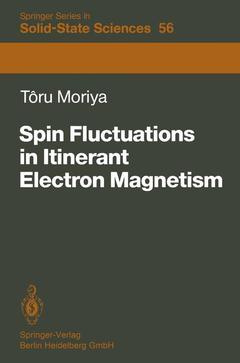Spin Fluctuations in Itinerant Electron Magnetism, Softcover reprint of the original 1st ed. 1985 Coll. Springer Series in Solid-State Sciences, Vol. 56
Langue : Français
Auteur : Moriya Toru

Ferromagnetism of metallic systems, especially those including transition metals, has been a controversial subject of modern science for a long time. This controversy sterns from the apparent dual character of the d-electrons responsible for magnetism in transition metals, i.e., they are itinerant elec trons described by band theory in their ground state, while at finite tem peratures they show various properties that have long been attributed to a system consisting of local magnetic moments. The most familiar example of these properties is the Curie-Weiss law of magnetic susceptibility obeyed by almost all ferromagnets above their Curie temperatures. At first the problem seemed to be centered around whether the d-elec trons themselves are localized or itinerant. This question was settled in the 1950s and early 1960s by various experimental investigations, in particular by observations of d-electron Fermi surfaces in ferromagnetic transition metals. These observations are generally consistent with the results of band calculations. Theoretical investigations since then have concentrated on explaining this dual character of d-electron systems, taking account of the effects of electron-electron correlations in the itinerant electron model. The problem in physical terms is to study the spin density fluctuati·ons, which are ne glected in the mean-field or one-electron theory, and their influence on the physical properties.
1. Introduction.- 1.1 Local Magnetic Moment and the Weiss Theory of Ferromagnetism.- 1.2 Magnetic Moments of Atoms.- 1.3 Heisenberg Localized Electron Model.- 1.4 Itinerant Electron Model.- 1.5 Localized vs Itinerant Electron Models.- 1.6 Random-Phase Approximation Theory of Spin Fluctuations in Itinerant Electron Magnets.- 1.7 Local Moments in Metals.- 1.8 Self-Consistent Renormalization Theory of Spin Fluctuations and Weakly Ferro- and Antiferromagnetic Metals.- 1.9 Unified Picture of Magnetism.- 1.10 Organization of the Book.- 2. Mean-Field Theory of Itinerant Electron Magnetism.- 2.1 Model Hamiltonians.- 2.2 Ferromagnetism.- 2.3 Antiferromagnetism.- 2.4 Spin-Density Waves.- 2.5 Stability of Various Spin Orderings.- 3. Dynamical Mean-Field Theory of Spin Fluctuations.- 3.1 Stoner Excitations and Spin Waves in Ferromagnetic Metals.- 3.2 General Spin Fluctuations and Dynamical Susceptibilities.- 3.3 Critical Spin Fluctuations.- 3.4 Antiferromagnets.- 3.5 Limitations of the Hartree-Fock-RPA Theory.- 4. Self-Consistent Renormalization (SCR) Theory of Spin Fluctuations.- 4.1 Expressions for the Free Energy of an Interacting Electron System.- 4.2 Paramagnon Theories.- 4.3 SCR Theory of Ferromagnetic Metals.- 4.3.1 Curie Temperature and Magnetic Susceptibility Above TC.- 4.3.2 Analytical Explanation of the New CW Law.- 4.3.3 Magnetization Below TC.- 4.3.4 Rotationally Invariant Treatment.- 4.4 Phenomenological Mode-Mode Coupling Theory.- 4.5 SCR Theory of Antiferro- and Helimagnetic Metals.- 4.6 Physical Origin of the New Curie-Weiss Susceptibility.- 4.6.1 Temperature Variation of the Mean-Square Local Amplitude of Spin Fluctuation.- 4.6.2 Spatial Spin Correlation.- 4.7 Coexistence of and Phase Transitions Between Ferro- and Antiferromagnetism.- 4.8 Quantitative Aspects of the SCR Theory for Weak Itinerant Ferromagnets.- 5. Physical Properties of Weakly and Nearly Ferro- and Antiferromagnetic Metals.- 5.1 Properties of Spin Fluctuations.- 5.2 Thermal Expansion.- 5.3 Specific Heat.- 5.4 Nuclear Spin Relaxation.- 5.4.1 Weakly and Nearly Ferromagnetic Metals.- 5.4.2 Weakly and Nearly Antiferromagnetic Metals.- 5.5 Electrical and Thermal Resistivities and Magnetoresistance.- 5.5.1 Weakly and Nearly Ferromagnetic Metals.- 5.5.2 Antiferromagnets.- 5.6 Coupling Between Spin and Charge Density Fluctuations.- 6. Local Magnetic Moments.- 6.1 Local Moments in Insulator Magnets.- 6.2 Metal-Insulator (Mott) Transition.- 6.3 s-d or s-f Exchange Model.- 6.4 Local Moment Formation in Metals.- 6.4.1 Virtual Bound State.- 6.4.2 The Anderson Model.- 6.4.3 The Wolff-Clogston Tight-Binding Model.- 6.5 Physical Properties of a Single Local Moment in Metals.- 6.6 Interaction Between a Pair of Local Moments in Metals.- 6.7 Local Moment Description of Magnetic Transition Metals.- 7. A Unified Theory and Its General Consequences.- 7.1 General Considerations Toward a Unified Theory.- 7.2 A Phenomenological Description of the Unified Theory.- 7.3 General Mechanism for the Curie-Weiss Susceptibility.- 7.3.1 A Mean Mode-Mode Coupling Theory of Magnetic Susceptibility.- 7.3.2 General Expressions for the Curie Temperature and Susceptibility.- 7.3.3 Spin Correlations and Magnetic Susceptibility.- 7.4 Possibility for Systematic Analyses of Experimental Results.- 7.5 Temperature Variation of the Local Amplitude of Spin Fluctuation.- 7.5.1 General Remarks.- 7.5.2 Temperature-Induced Local Moments.- 7.6 Limitations of the Adiabatic Approximation.- 8. Functional Integral Theory.- 8.1 Basic Formalism.- 8.2 Local Moment in Metals.- 8.3 Band Magnetism — A General Formalism.- 8.4 Methods of Calculating the Free Energy Functional.- 8.4.1 A Closed-Form Expression for ? [?, ?].- 8.4.2 Long-Wavelength Approximations.- 8.5 A Unified Description of Magnetism in Narrow-Band Systems.- 8.6 Approximation Methods of Evaluating the Functional Integrals.- 8.6.1 Unified Theory.- 8.6.2 Molecular Field (Single-Site) Approximation.- 8.6.3 Choice of Forms for the Interaction Hamiltonian.- 8.7 Results of Numerical Calculations.- 8.7.1 Ferromagnetic Transition Metals ?-Fe, Co, Ni.- 8.7.2 Antiferromagnetic Transition Metals.- 8.7.3 FeSi, Nearly Ferromagnetic Semiconductor.- 8.7.4 Temperature-Induced Local Moments in CoS2, CoSe2.- 8.7.5 Magnetovolume Effects.- 8.8 Supplementary Discussions on Various Approaches and Physical Pictures.- 8.8.1 The Hartree-Fock Theory for Excited States with Spatially Varying Spin Density.- 8.8.2 Local Band Theory.- 8.8.3 Persistence of Exchange Splitting of the Band Above TC.- 9. Spin Fluctuations in d-Electron Systems.- 9.1 Spin Fluctuations and Neutron-Scattering Measurements.- 9.2 Local Moment Systems.- 9.2.1 Heusler Alloys.- 9.2.2 EuO.- 9.3 Substances Close to the Local Moment Limit.- 9.3.1 MnPt3, FePd3.- 9.3.2 FePt3.- 9.4 Substances Close to the Weakly Ferro- and Antiferromagnetic Limits.- 9.4.1 MnSi.- 9.4.2 Cr.- 9.5 Substances in the Intermediate Regime: q-Space Description.- 9.5.1 Fe3Pt.- 9.5.2 CeFe2.- 9.5.3 ?-Mn, ?-(FeMn), ?-Fe.- 9.5.4 ?-Mn.- 9.6 Ferromagnetic Transition Metals Fe, Co, and Ni.- 9.7 Some Systematic Trends in Paramagnetic Scattering.- 10. Toward a Unified Theory of Dynamical Spin Fluctuations.- 10.1 General Considerations.- 10.2 Green’s Function Theory of Dynamical Susceptibilities.- 10.3 Effect of Electron Lifetime on RPA-SCR Spin Fluctuations.- 11. Concluding Remarks.- References.
Date de parution : 11-2012
Ouvrage de 242 p.
15.5x23.5 cm
© 2024 LAVOISIER S.A.S.



